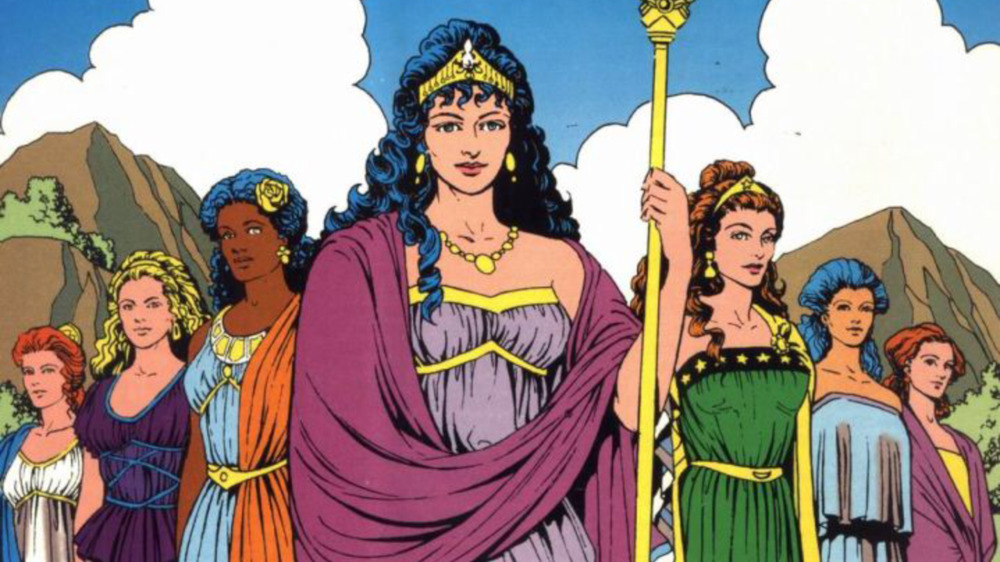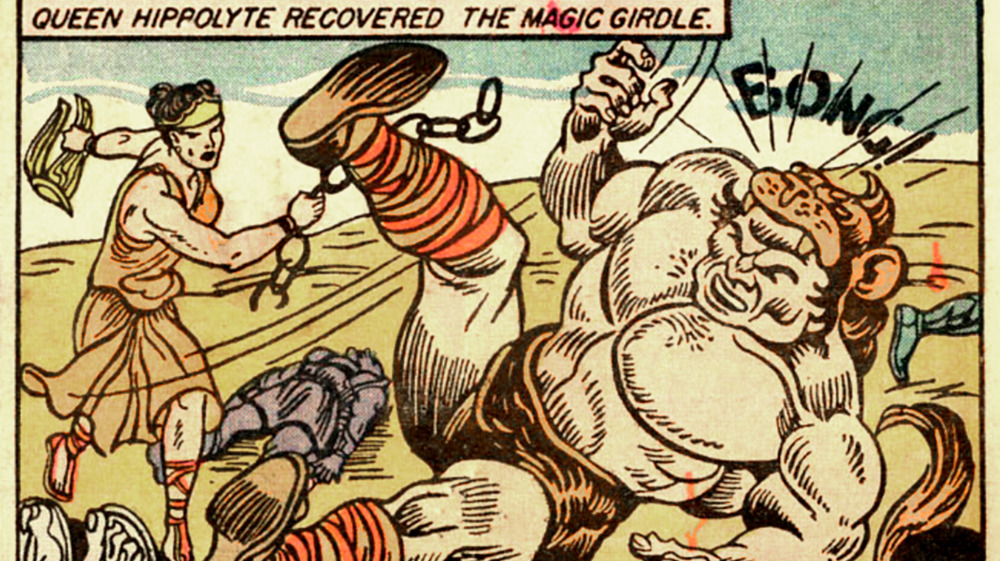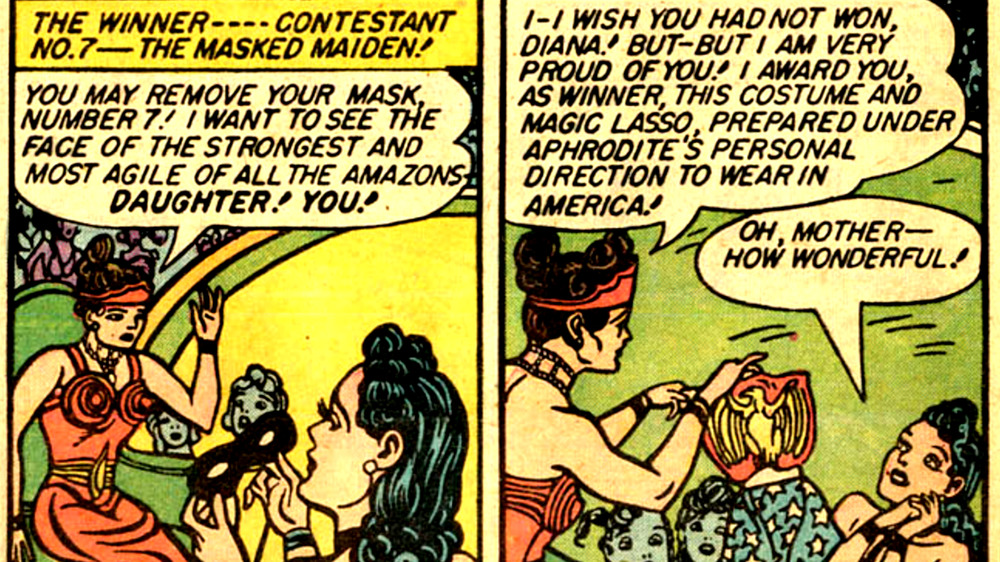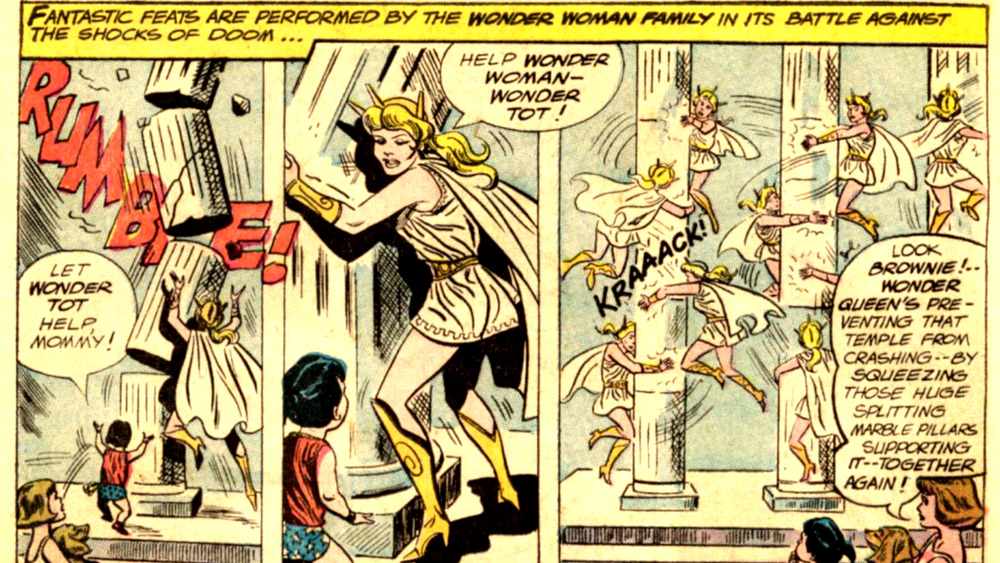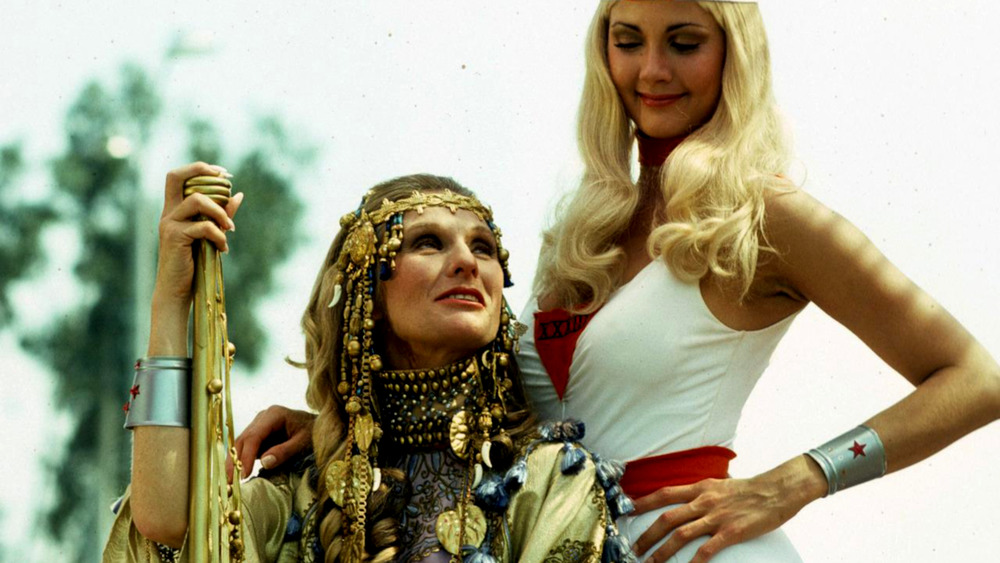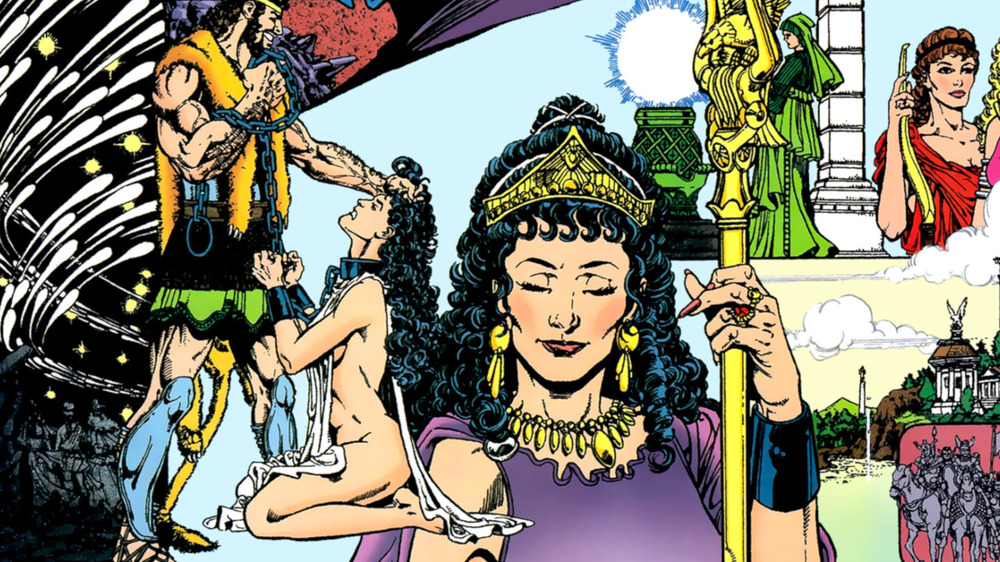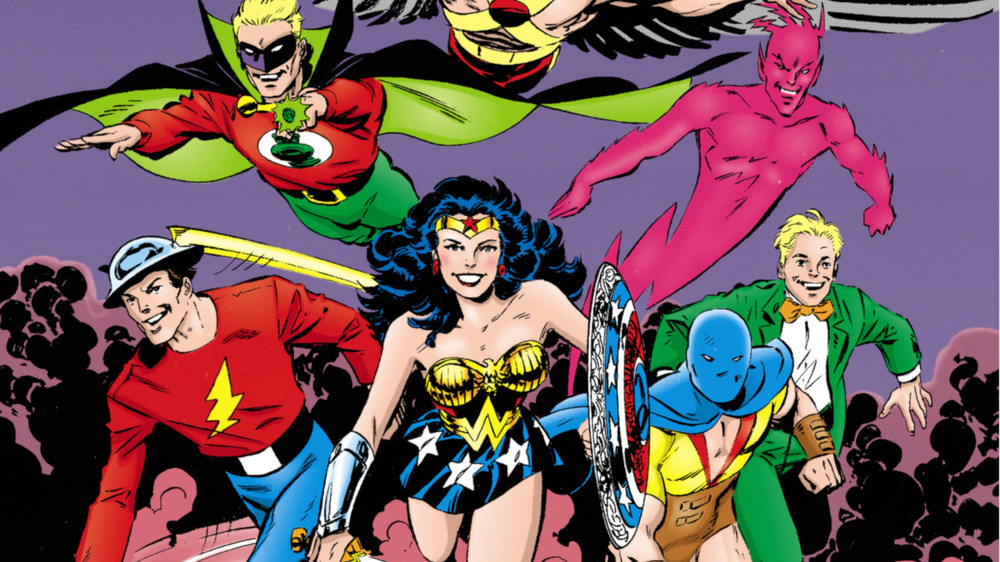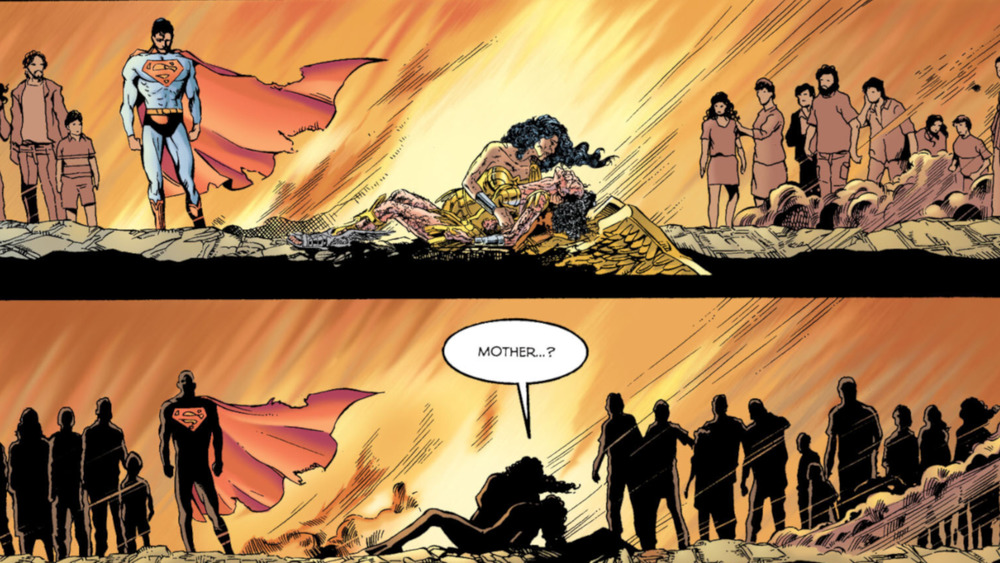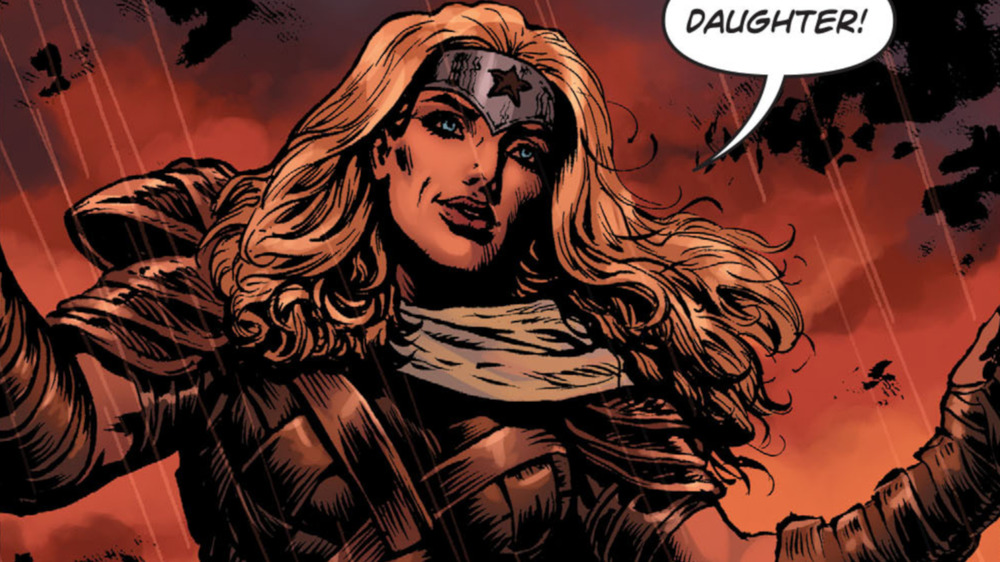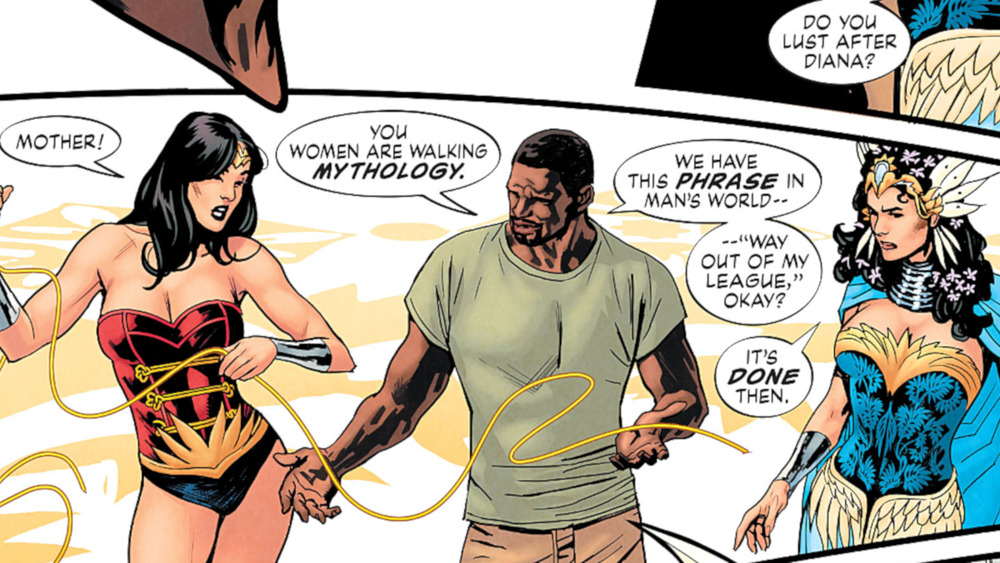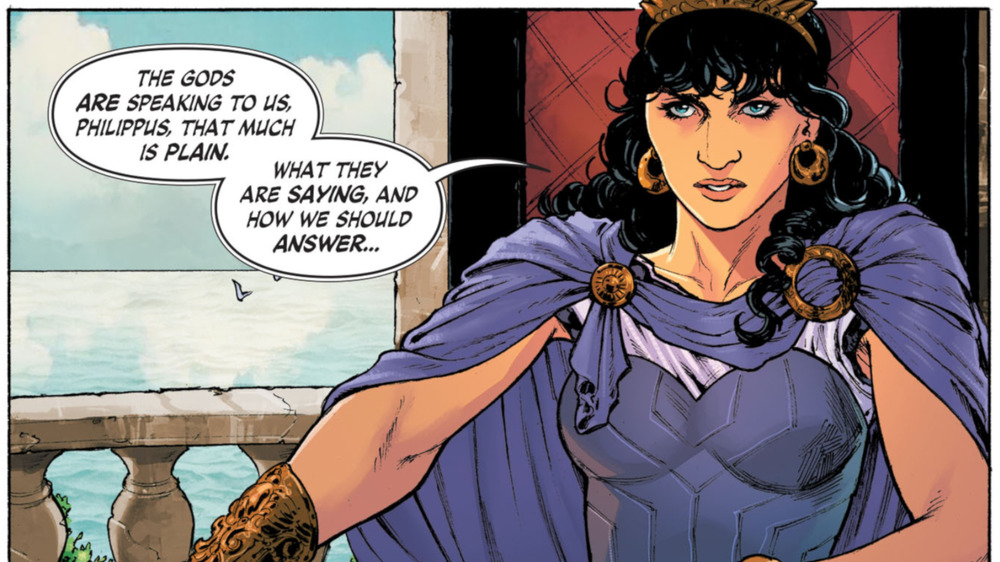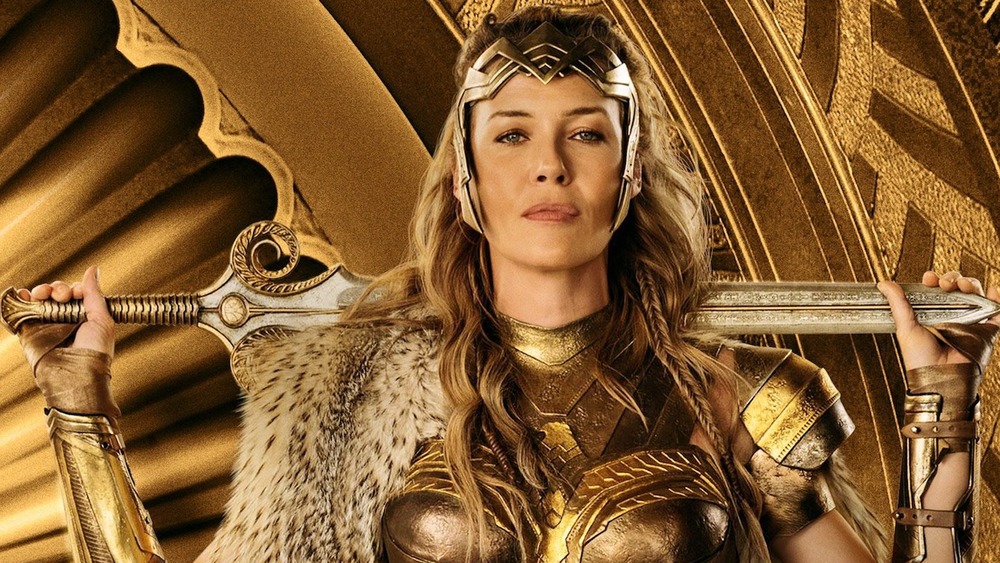The Untold Truth Of Queen Hippolyta
Wonder Woman 1984 comes out this month! That's got us all thinking about the Amazing Amazon, also known as Princess Diana, and the magical world that surrounds her. No disrespect to Steve Trevor, but the single most important member of Wonder Woman's supporting cast has to be her mother, Queen Hippolyta of Themyscira, queen of the Amazons.
Hippolyta has appeared in every adaptation of Wonder Woman, and every era of the comics. That said, she's been reinvented over and over again, which makes it confusing sometimes to figure out what her deal is. A thoughtful philosopher queen? A battle-hardened weapons master? Cloris Leachman? Let's take a journey through the decades of DC Comics, and see if we can't get a stronger understanding of who Queen Hippolyta is, and how she and her relationship to her daughter have been refined and revised over the 80 or so years since they debuted in DC Comics.
Mythological origins
Thousands of years before the invention of comics, Queen Hippolyta (sometimes Hippolyte) was already a powerful character in Greek mythology. The Queen of the Amazon is probably best remembered as a minor character in the story of Heracles (also known as Hercules). The Ninth of Heracles' famous Twelve Labors was to retrieve the belt, or girdle, of Hippolyta as a gift for Admete, daughter of King Eurystheus. When Heracles reached Themyscira, the Queen was impressed with his heroic exploits and willingly gave him the girdle. As Heracles and his men prepared to leave, the Goddess Hera spread rumors among the Amazons that Heracles was planning to kidnap their queen. The Amazons attacked Heracles, who assumed this had been Hippolyta's plan all along, and he responded by killing the Amazon Queen.
At least, he killed her according to that particular story. In other versions of the myth, she survived and went on to marry another mythological hero, Theseus. As the bride of Theseus she appears not only in Classical myths, but also in Shakespeare's comedy A Midsummer Night's Dream, in which the wedding of King Theseus and Queen Hippolyta provides a backdrop for a story of confused lovers and mischievous fairies.
Original 1940s version
When William Moulton Marston and Harry G. Peter created the first Wonder Woman comics in the early 1940s, they included the mythological Queen of the Amazons as the mother of their new character Princess Diana, who would become Wonder Woman. Averting the need for a father among the all-female Amazons, Hippolyta had sculpted the infant Diana out of clay, and the Goddesses then brought her to life.
Queen Hippolyta is portrayed as an intelligent and caring ruler, in keeping with Marston's political beliefs about the superiority of women as leaders. She is also quite protective of her daughter, even forbidding Diana to take part in the tournament to determine which Amazon will leave the island and become Wonder Woman. However, when Diana enters the tournament in disguise and wins, Hippolyta abides by that result, helping her daughter take on the role of Wonder Woman.
In the original printings of these comics, Queen Hippolyta is portrayed with dark brown hair. Later reprints would recolor her as a blonde, to match the version that became common in the years to come.
Evolution over the decades
As the Golden Age of Comics gave way to the Silver Age, the now-blonde Queen Hippolyta took a more active role in her daughter's adventures. Following the success of stories about Wonder Girl (Princess Diana in her teenage years) and Wonder Tot (Diana as a toddler), writer Robert Kanigher began writing self-described "impossible stories" in which all three versions of Diana teamed up to have adventures together. Queen Hippolyta, who'd already been playing an understandably enlarged role in the stories of Diana as a minor, became the fourth member of what Kanigher called the Wonder Woman family. She even took on the name "Wonder Queen," becoming something of a superhero herself, albeit in a particularly goofy milieu.
When the Wonder Woman comics began moving away from all this Silver Age silliness, with Wonder Tot and Wonder Girl falling by the wayside (although the latter would evolve into her own character in the pages of Teen Titans), Hippolyta took more of a backseat. In fact, the well remembered era in which Diana Prince became a globe-trotting hero with no costume or powers was prompted by Hippolyta taking the Amazons to another dimension. When Diana refused to leave Man's World behind she instead gave up her powers and costume, saying a tearful goodbye to her mother. Naturally, when Wonder Woman got back to her roots, Queen Hippolyta and the Amazons returned, just in time to move into a new medium.
Hippolyta on the 'Wonder Woman' TV show
When the popular live-action Wonder Woman TV show launched in 1975, the premiere episode featured the legendary actress Cloris Leachman as a memorable Queen Hippolyta. Loving, authoritative, judgmental towards Man's World, and just a little bit scattered, Leachman's Hippolyta was perfectly suited for the uniquely campy yet sincere tone of the Wonder Woman series.
Unfortunately, Cloris Leachman never returned to the role after that first double-length episode. Carolyn Jones, best known as the original Morticia Addams, played Hippolyta in three episodes, before Oscar and Tony winner Beatrice Straight took over the role for the Amazon Queen's final two appearances on the show.
Naturally Hippolyta would also appear alongside her daughter in various animated series over the years. She was voiced by Pat Carroll in a Wonder Woman-centric episode of the 1988 Superman cartoon, for example, and by Susan Sullivan in Justice League and Justice League Unlimited.
1980s reboot
When George Pérez rebuilt Wonder Woman's mythos from the ground up in the wake of Crisis on Infinite Earths, he turned to Classical Mythology for inspiration on both the narrative and the aesthetics. The first issue of Wonder Woman Vol. 2 tells the history of the Amazons, including Hippolyta's subjugation by Heracles. In the DC Universe version of that story, Hippolyta and the Amazons were enslaved by Heracles and his men, but then broke free with the help of their patron Goddesses and removed themselves to Themyscira, away from the aggressions of men.
In keeping with the Mediterranean aesthetic, Pérez's Hippolyta had black hair rather than blonde, and in fact bore a closer resemblance to her daughter Diana than ever before. As Pérez draws them, Hippolyta's curlier hair and more distinguished cheekbones are the only things that really set them apart. A decade or so later, this resemblance would be put to narrative use in an unexpected storyline.
Wonder Woman of the 1940s
Wonder Woman got her start in 1941, and had been a member of the Justice Society of America, DC's premier Golden Age superhero team. With the Crisis on Infinite Earths reboot, however, the Wonder Woman of the 1940s no longer existed, and therefore was never in the Justice Society. Writer/artist John Byrne, who took over Wonder Woman in the late '90s, had an idea to fix that problem.
During Byrne's run, Princess Diana was killed and then granted immortality by the Gods, ascending to Mount Olympus herself as the Goddess of Truth. In her wake, Queen Hippolyta herself became the new Wonder Woman. She wore a more old-fashioned costume, with the golden eagle on her chest rather than the winged double-W, and a skirt rather than shorts. She also carried a sword and shield instead of Diana's magic lasso.
On one of her earliest adventures, Hippolyta traveled back in time to the early 1940s, where she ultimately stayed for eight years. In that era, she joined the Justice Society, filling the role of the Golden Age Wonder Woman. Upon returning to the present, she also took Diana's place in the Justice League. Eventually, of course, Diana came back down from Olympus and resumed the Wonder Woman role. Hippolyta wasn't ready to give it up, however, and the two shared the name for a time.
The death of Hippolyta
In the 2001 DC Comics crossover story Our Worlds At War, a powerful alien known as Imperiex threatened all life on Earth. Still active as Wonder Woman at the time, Hippolyta gave her life to stop Imperiex, dying in her daughter's arms. Her sacrifice was honored by her fellow superheroes, as well as all the Amazons over whom she'd ruled so benevolently.
Of course, almost no death in comics is ever permanent, and Hippolyta eventually returned to life, not as Wonder Woman but as the Queen of the Amazons. Specifically, the villainous sorceress Circe resurrected Hippolyta to show her that her daughter Diana was being held prisoner and even tortured by the U.S. government for refusing to hand over the Amazons' purple ray technology. Hippolyta reacted to this news precisely as Circe had so clearly hoped she would, rallying the other Amazons to attack Washington DC, thus kicking off the Amazons Attack storyline. After that storyline ended, Hippolyta was left as the only Amazon on Themyscira for a time, but history was soon to be reset anew.
New 52: A more brutal Hippolyta
In 2011, the continuity of the DC Universe was reset as part of the line-wide "New 52" relaunch. Brian Azzarello and Cliff Chiang were given the task of rebooting Wonder Woman, and they created a much darker version of Themyscira, lead by a warlike blonde Hippolyta in red battle armor. This Amazon Queen, it turned out, had not sculpted Princess Diana from clay. Instead, she'd been impregnated by the Greek God Zeus, thus making Wonder Woman a literal demigoddess.
Furthermore, it was soon revealed that the Amazons had a longstanding tradition of seeking out sailors to impregnate them, and then turning over any male offspring to the Blacksmith God Hephaestus. In the wake of this startling (and some might say, character-breaking) revelation, HIppolyta was turned to stone, while the rest of the Amazons other than Diana were turned into snakes. Tonally, the whole thing was pretty jarring to longtime Wonder Woman fans, but fortunately it wouldn't be long until it would all be undone.
Hippolyta in Wonder Woman: Earth One
DC's "Earth One" graphic novel series is an attempt to retell their heroes' classic stories for 21st Century audiences, without the restraints of continuity. In 2016, Grant Morrison and Yanick Paquette released the first volume of Wonder Woman: Earth One, reimagining Wonder Woman's origin with a combination of Golden Age elements and modern sensibilities. This version of Themyscira, for example, was overtly lesbian, with both Hippolyta and Diana showing affection for female partners. Paquette also brought a lavish aesthetic to Hippolyta and the other Amazons, with their outfits incorporating feathers and flowers.
Unfortunately, this version of Hippolyta espouses a strawman-ish feminism that's so strident it reads as a parody. At one point she quotes Valerie Solanas' SCUM Manifesto almost word-for-word. She's also extremely suspicious of Steve Trevor's intentions toward her daughter, which is perhaps an even worse look than it would otherwise be, since this version of Steve Trevor is a black man.
'Rebirth' brings back 1980s Hippolyta
When the "DC Rebirth" event offered another opportunity to resent continuity, writer Greg Rucka took it upon himself to undo virtually everything Azzarello had done to Wonder Woman and the Amazons. The brutal Themyscira ruled by the red-armored blond Hippolyta was revealed to be an illusion created to keep Princess Diana ignorant of her true homeland. The real Queen Hippolyta had black hair once more, and in general closely resembled George Pérez's 1980s version of the character, although artists Bilquis Evely and Liam Sharp put their own modern spin on things.
In this continuity, Diana is kept away from Themyscira by magic, and is only able to see her real mother briefly. It was enough, at least for the time being, for Wonder Woman to know that her mother and her people are proud of her. Rucka was unable to undo the "child of Zeus" thing, although given how unmentioned it goes during his run, you're definitely left with the impression that he would have if he could.
Hippolyta in the movies
Actress Connie Nielsen played Queen Hippolyta in Patty Jenkins' Wonder Woman and Zack Snyder's Justice League, both released in 2017. A blonde-haired warrior woman in her own right, this Hippolyta brings in elements from many different versions of the comic book character. Moreover, she looks extremely imposing in her golden armor, and makes a fitting parent for Gal Gadot's Diana. Hippolyta's sister Antiope, usually portrayed as long-dead in the comics, is also a character in the movie, portrayed by an imposing Robin Wright as the leader of Themyscira's army.
Nielsen reprises her role in the upcoming Wonder Woman 1984. As far as we know, Princess Diana is still unable to return to Themyscira, but the trailers show flashbacks to her childhood there, which will certainly include scenes with her mother. It's also possible we'll see Hippolyta and the Amazons in the present but without Diana, as we did in Justice League. Only time will tell what the future holds for Hippolyta — in the movies, the comics, and beyond.
